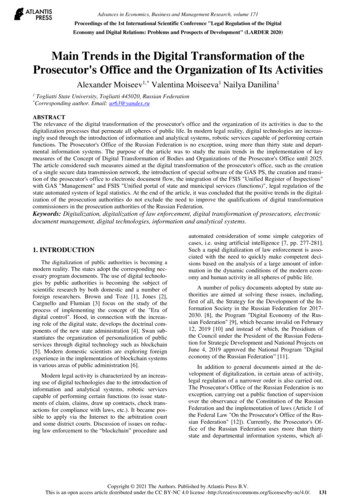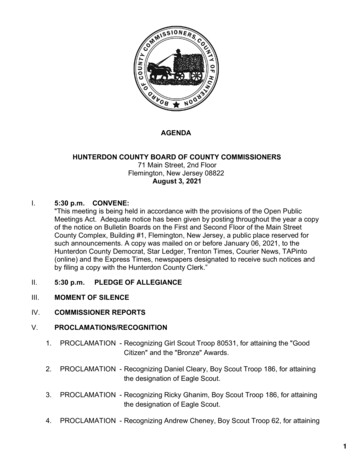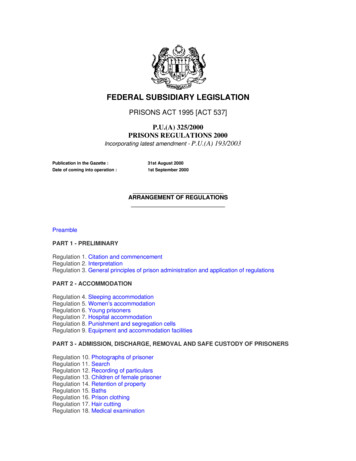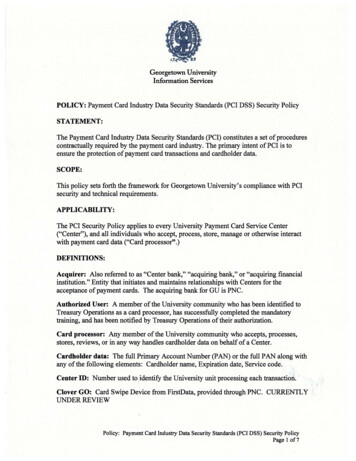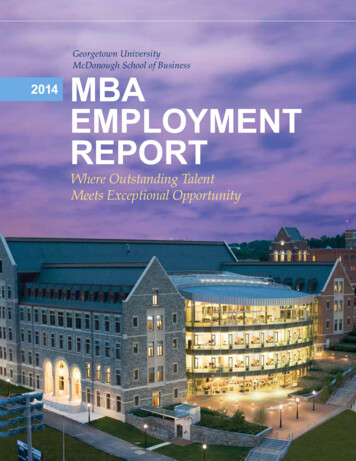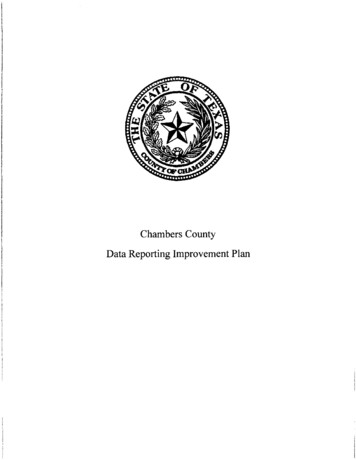
Transcription
REGULATION BY PROSECUTORGregory M. Gilchrist*ABSTRACTProsecutors exercise broad power and nearly unchecked discretion. A distinctive and underappreciated aspect of prosecutorial authority lies in the ability toimpose plea terms that effectively ensconce the prosecutor as a regulator. Thisphenomenon is clearest in corporate settlements mandating prospective changesto internal governance subject to ongoing prosecutorial review. Prosecutorialcontrol of corporate governance, however, represents merely an extension of alongstanding practice. Prosecutors have often demanded prospective and remedial terms to resolve a wide array of criminal cases, including traditional casesagainst individuals. Such terms include bars from employment, compelled apologies, and bans from public office. Regulation by prosecutor is a predictable consequence of expansive criminal laws, the practical realities of plea bargaining,and the perceived failure of regulators; as such, it is unlikely to change. Thequestion remains whether and how it might be governed. This Article representsa first step toward describing the breadth of the phenomenon, identifying its benefits and costs, and considering paths forward.INTRODUCTIONIn the popular imagination, prosecutors investigate crimes and advocate for punishment. The real function of prosecutors, however, is continually expanding.1Recently, in the context of corporate crime, the expansive prosecutorial functionhas come under renewed scrutiny as prosecutors are resolving criminal investigations via remedial measures that resemble regulation more than punishment.It is now routine for a corporate defendant to settle a criminal investigationby agreeing to remedy internal compliance and governance mechanisms. Some* Professor of Law, University of Toledo College of Law. A.B. Stanford; J.D. Columbia. I would like to thankall those who contributed to this Article through comments and discussions of earlier drafts, including KaraBruce, Mihailis Diamantis, Ken Kilbert, David Kwok, Lee Strang, and Evan Zoldan. I am especially grateful toVeronica Root and Thomas Joo for their comments on an early draft that fundamentally improved my arguments.As always, errors and mistakes are my own. 2019, Gregory M. Gilchrist.1. See Kay L. Levine, The New Prosecution, 40 WAKE FOREST L. REV. 1125, 1126 (2005) (“During the pasthalf century, the prosecutor has emerged as the empire builder of the American criminal justice system. Takingadvantage of legislative efforts to limit judicial discretion, the prosecutor’s office has siphoned revenue, power,and control from the bench and has become the principal actor responsible for determining case outcomes andsentences for criminal defendants.”).315
316AMERICAN CRIMINAL LAW REVIEW[Vol. 56:315corporate settlements go further by mandating ongoing monitoring.2 And a few goeven further, including terms that govern not only compliance and governance, butalso more purely regulatory matters such as workplace safety and environmentalpractices.3 In all these cases, the prosecutor remains the de facto arbiter, assuminga role of prospective governance different in kind from that of an advocate. In thisway, prosecutors have expanded from serving only as post hoc adjudicators to alsoworking as ex ante governors. That is, prosecutors have become regulators.This Article suggests that while the prosecutorial shift to a regulatory function isimportant, it is neither new nor limited to the corporate sphere. Prosecutors haveexercised something like an ongoing regulatory power over defendants in a widearray of non-corporate cases for a long time. This power is amplified and moreobvious in the corporate context, if only because its impact is more widespread,but the practice is not fundamentally new.Recognizing the scope of prosecutorial regulatory power is important becauseprosecutors enjoy broad and near unfettered discretion. That discretionary powerhas been justified largely, if not entirely, in the context of prosecutors’ more traditional adjudicative role. To recognize that prosecutors exercise an additional function, as prospective arbiters of something like individualized regulations, invitesfurther consideration of how prosecutors ought to be governed.Corporate criminal law is a useful lens through which to view criminal law andprocess more generally, in part because the two are an uncomfortable fit.Corporations have always represented a theoretical challenge for criminal law.The criminal law is distinctively moral and condemnatory, yet these concepts aredifficult to apply to the corporate form.4 Likewise, the archetypal criminal sanctions involve deprivation of liberty and corporal punishment, neither of which areapplicable to corporations. The question of what exactly we are doing by applyingcriminal law to corporations is as old as it is familiar.5Because blame and punishment hang awkwardly on the corporate frame, corporate criminal law enforcement emphasizes remediation.6 Rather than just seekingto punish the corporation, prosecutors seek to reform it. Corporations are still finedfor criminal misconduct, but there is an emphasis on good governance and2. Veronica Root, Constraining Monitors, 85 FORDHAM L. REV. 2227, 2230 (2017) (“In an enforcementmonitorship, the monitor acts as an agent of the government . . . and ensures that the monitored organizationcomplies with the government’s specifications.”).3. See infra Section II(B).4. Moral desert is most commonly understood as contingent on certain capacities, and while philosophersdiffer as to what capacities are necessary, most would include autonomy. Michael Moore describes the kind ofautonomy necessary (although not necessarily sufficient) for desert as the “capacity to choose and cause therealization of one’s choice.” MICHAEL S. MOORE, PLACING BLAME: A GENERAL THEORY OF THE CRIMINAL LAW612 (1997).5. John C. Coffee, Jr., “No Soul to Damn: No Body to Kick”: An Unscandalized Inquiry Into the Problem ofCorporate Punishment, 79 MICH. L. REV. 386, 386 (1981).6. And, more controversially, expression. See Gregory M. Gilchrist, The Expressive Cost of CorporateImmunity, 64 HASTINGS L. J. 1, 30 (2012).
2019]REGULATION BY PROSECUTOR317compliance: the corporate mechanisms by which future misconduct can be minimized if not avoided.While the moral status of corporations may be questioned, the legal concept ofguilt is not.7 Corporations do commit crimes. More precisely, human beings serving as agents of the corporation commit crimes within the scope of their agency.When this happens, the law is clear: the corporation can be held criminally liable.8Most often criminal action on behalf of the corporation results in a negotiatedsettlement, not a contested conviction. Few days pass without headlines describingthe fines some corporation has agreed to pay to resolve allegations of criminal conduct. Volkswagen incurred billions in fines when it was discovered the companyhad equipped cars with emissions-cheating software designed to evade Clean AirAct requirements.9 Wells Fargo paid 185 million in fines when it was revealedthat over 5,300 sales personnel had been terminated for creating sham accounts forcustomers in an effort to meet unrealistic sales quotas.10 And although the investigation into Equifax’s historic loss of sensitive consumer data has not yet resolved,in the months following the breach, the company’s shares lost thirty-five percent oftheir value,11 and some experts expect an historically large fine.12News of a large corporation being convicted of a crime is less frequent, but ithappens. For example, Quality Egg LLC actually pled guilty to bribing a public official and introducing misbranded and adulterated food into interstate commerce.13News of a large corporation being tried for a crime is less frequent still.14 In this7. Interstitially, there is the question of collective action. For more on collective action and moral status, seeDavid Copp, Collective Actions and Secondary Actions, 16 AM. PHIL. Q. 177, 185 (1979) (“[T]he actions ofcollectives are constituted by actions of persons, and a collective is not a self-sufficient agent. Not being a selfsufficient agent, moreover, it follows that a collective is not a self-sufficient moral agent.”).8. See N.Y. Cent. & Hudson River R.R. Co. v. United States, 212 U.S. 481, 495 (1909) (stating thatcorporations may be held criminally liable for acts of an agent).9. Hiroki Tabuchi, Jack Ewing, & Matt Apuzzo, 6 Volkswagen Executives Charged as Company PleadsGuilty in Emissions Case, N.Y. TIMES (Jan. 11, 2017), agen-diesel-vw-settlement-charges-criminal.html (“The automaker is set to pay 4.3 billion in criminaland civil penalties in connection with the federal investigation, bringing the total cost of the deception toVolkswagen in the United States, including settlements of suits by car owners, to 20 billion—one of thecostliest corporate scandals in history.”).10. Michael Corkery, Wells Fargo Fined 185 Million for Fraudulently Opening Accounts, N.Y. TIMES (Sept.8, 2016), .html.11. Tara Siegel Bernard, Prosecutors Open Criminal Investigation Into Equifax Breach, N.Y. TIMES (Sept.18, 2017), x-breach-federal-investigation.html.12. See, e.g., Martin Vlcek, Equifax Could Face a 2.75B Bill, SEEKING ALPHA (Sept. 16, 2017), ace-2 75b-bill?page 2.13. Press Release, U.S. Dep’t of Justice, Quality Egg, Company Owner and Top Executive Sentenced inConnection with Distribution of Adulterated Eggs (Apr. 13, 2015), ibution-adulterated.14. The streamlined system of justice seemingly available to corporations was the subject of Judge Young’srecent rejection of a proposed plea agreement between the United States and Aegerion Pharmaceuticals. SeeUnited States v. Aegerion Pharm., 280 F. Supp. 3d 217 (D. Mass. 2017). Aegerion was accused of havingengaged in “a series of unfair and deceptive acts, including outright fraud, which pervaded corporatemanagement, all designed to increase the use of [a profitable drug] in circumstances where such treatment was
318AMERICAN CRIMINAL LAW REVIEW[Vol. 56:315way corporations are like people: they plea bargain in criminal cases.15 Indeed,corporations resolve criminal cases by settlement with greater frequency than people.16 This fact should be unsurprising. People go to prison, but corporations justpay fines. The whole enterprise is inherently less dramatic and hence more amenable to resolution by settlement.Since 2001, federal prosecutors have increasingly relied on Deferred andNon-Prosecution Agreements (D/NPAs)—basically contractual settlementsprior to prosecution—to revolve corporate criminal investigations. With moreuse, D/NPAs have introduced new and broader terms aimed at reform ratherthan retribution.Whereas prosecutors traditionally work toward imposing retroactive retribution, D/NPAs demand prospective remediation. It is not uncommon for prosecutors to mandate changes to corporate governance in corporate settlements.17Many have suggested this shift has expanded, perhaps improperly or imprudently, the function of prosecutors. For example, Jennifer Arlen and MarcelKahan argue that corporate law enforcement has “transform[ed] prosecutorsinto firm-specific quasi regulators.”18The seeming novelty is that prosecutors impose prospective, defendant-specificrules, and subsequently serve as the de facto arbiter of compliance. This practice,however, extends well beyond the corporate context. Prosecutors generally havewide discretion over when and whether to notice a probation violation,19 and in thisnot medically indicated.” Id. at 218. Judge Young rejected the plea, maintained the original trial date, andlamented what he describes as a “[t]wo-[t]ier [c]riminal [j]ustice [s]ystem.” Id. at 221.15. Of all federal felony cases terminated in FY2016, over 90 percent resulted in conviction and less than 4percent went to trial. U.S. DEP’T OF JUSTICE, UNITED STATES ATTORNEYS’ ANNUAL STATISTICAL REPORT,FISCAL YEAR 2016 7 (2016), load.16. See Gideon Mark, The Yates Memorandum, 51 U.C. DAVIS L. REV. 1589, 1607 (2018) (noting “the greaterpropensity of individuals to refuse to settle compared with corporations”).17. See Wulf A. Kaal & Timothy A. Lacine, The Effect of Deferred and Non-Prosecution Agreements onCorporate Governance: Evidence from 1993-2013, 70 BUS. LAW. 61, 62 (2015) (“The increasing use of Nonand Deferred Prosecution Agreements . . . has enabled federal prosecutors to incrementally expand theirtraditional role, exemplifying a shift in prosecutorial culture from an ex-post focus on punishment to an ex-anteemphasis on compliance.”).18. Jennifer Arlen & Marcel Kahan, Corporate Governance Regulation Through Nonprosecution, 84 U. CHI. L.REV. 323, 327 (2017); see also Peter Spivack & Sujit Raman, Regulating the “New Regulators”: Current Trends inDeferred Prosecution Agreements, 45 AM. CRIM. L. REV. 159, 161 (2008). Arlen and Kahan note that theseremedial corporate settlements are distinguished from traditional prosecutions and traditional regulations by twofactors: the post hoc determination of penalties for substantive violations renders them not-quite-regulatory, and thepotential for probationary violations absent any substantive harm render them not-quite-prosecutorial. Arlen &Kahan, supra note 18, at 327. Drawing attention to the relationship between prosecution and regulation is not new.It has been more than 35 years since Roberta Karmel published her critique of a shift toward a prosecutorial stanceat the traditionally regulatory Securities and Exchange Commission. See ROBERTA S. KARMEL, REGULATION BYPROSECUTION: THE SECURITIES AND EXCHANGE COMMISSION VERSUS CORPORATE AMERICA (1981). The instantarticle considers nearly the inverse point: the seizing of regulatory authority by prosecutors.19. Kate Weisburd, Monitoring Youth: The Collision of Rights and Rehabilitation, 101 IOWA L. REV. 297, 329(2015) (describing the “wide discretion afforded to probation officers and prosecutors about if and when to file aformal probation violation”).
2019]REGULATION BY PROSECUTOR319way prosecutors serve as arbiters of the terms they impose during the plea-bargainingprocess.20 As the terms of probation have expanded, so has the potential regulatoryrole of prosecutors. Accordingly, prosecutors now regulate such matters as whethera former-defendant may run for office, return to particular employment, or bedeemed to have offered sufficient public apologies. In each case, these powers arelimited to a single person and not a large, public corporation, but the powers are similar to those exercised in the corporate context. They are prospective, remedial, andchecked only in a limited manner. Prosecutors are regulators in all sorts of cases.Viewed in context, the shift toward regulation through D/NPAs is properlyunderstood not as something new. Rather, the corporate regulatory shift continuesa longstanding trend of prosecutors shifting their emphasis from retrospective punishment to prospective remedies. While prosecutors do enjoy broad power to regulate corporations through D/NPAs, that power is not fundamentally different fromthe power prosecutors generally exercise in criminal cases. Rather, the expansivepower exercised by prosecutors in these corporate settlements follows the sametrend in more traditional cases.This Article proceeds in five sections. Section I introduces the traditionally retributive prosecutor in America. Section II introduces examples of forward-looking,remedial, and regulatory terms demanded by prosecutors in corporate settlements,and describes how these terms differ at least in effect from those described in individual cases. Section III provides examples of prosecutors branching beyond theirretributive function by imposing in forward-looking remedial terms as means ofresolving criminal matters. These examples involve non-corporate scenarios, thusestablishing that the trend observed in D/NPAs is not entirely new. Section IV identifies factors contributing to the shift in prosecutorial authority, including expansivecriminal laws, the law of probation and plea bargaining, regulatory failures, and apublic demand for expressive justice. Finally, Section V assesses the benefits andcosts of using prosecutorial regulation as a mechanism of social control.It is important to recognize these benefits and costs. Regulation by prosecutor, itturns out, is a sufficiently broad phenomenon as to defy singular judgment.Moreover, and contrary to recent criticisms about a newfound expansion of prosecutorial authority in the corporate context, the shift is well-established and tooentrenched to anticipate significant change. The regulatory state of prosecutions isthe predictable consequence of plea bargaining, discretion, and regulatory failure;to prevent it, one would need to address one or more of these preconditions. Amore realistic and likely response would be better supervision of the prosecutorialfunction more tailored to the modern role of prosecutors as regulators.20. Courts formally set the terms of probation, but the prosecutor frequently dictates these terms as requiredcomponents of a plea agreement. See George Fisher, Plea Bargaining’s Triumph, 109 YALE L.J. 857, 942 (2000)(giving a historical overview of the argument that “probation grew up in symbiosis with prosecutorial pleabargaining”).
320AMERICAN CRIMINAL LAW REVIEW[Vol. 56:315I. PROSECUTORS: FROM PUNISHERS TO REGULATORSProsecutors as we know them are an American contribution to common law.21At the time of our founding, private prosecutions were the British norm.22 Atcommon law, the criminal justice system functioned when a victim appearedbefore a court to make a claim.23 Public prosecutions are an innovation dating tocolonial times.24 Today, American criminal justice is thoroughly public andprofessionalized.25The public prosecutor traditionally had two roles: first, to investigate potentialcrimes, and second, to try them before the court.26 Inherent in the latter was thepower to not try a case before the court: declination.27 As it turned out, prosecutorial authority and influence was enhanced more by the power not to prosecute thanthe power to prosecute. In a system without discretion, prosecutors would be mereadvocates. In our system, however, prosecutors have nearly28 unfettered discretion21. See John L. Worrall, Prosecution in America: A Historical and Comparative Account, in THE CHANGINGROLE OF THE AMERICAN PROSECUTOR 3, 5 (John L. Worrall & M. Elaine Nugent-Borakove, eds., 2008) (“Publicprosecution is not a result of our British common law heritage.”).22. See Jack M. Kress, Progress and Prosecution, 423 ANNALS AM. ACAD. POL. & SOC. SCI. 99, 100 (1976).23. Id. (“The aggrieved victim, or an interested friend or relative, would personally arrest and prosecute theoffender, after which the courts would adjudicate the matter much as they would a contract dispute or a tortiousinjury.”); see also John H. Langbein, Understanding the Short History of Plea Bargaining, 13 LAW & SOC’YREV. 261, 263 (1979) (describing criminal cases in London during the 1730s, where prosecutions were “inpractice virtually never” conducted by a lawyer).24. See Worrall, supra note 21, at 6 (“By 1704, Connecticut adopted a system of public prosecution, and othercolonies soon followed.”); see also Walter M. Pickett, The Office of Prosecutor in Connecticut, 17 AM. INST.CRIM. L. & CRIMINOLOGY 348, 352 (1926) (“Historically, the office of State’s Attorney traces back to the King’sor Queen’s attorney of colonial days. . . . In 1704 the ‘attorney’ for the Queen is required to ‘prosecute andimplead in the law all criminal offenders, and do all things necessary or convenient as an attorney to suppressvice and immorallities.’”) (quoting 4 Cononial Records, 468). There are earlier examples of public prosecutors.Langbein identifies justices of the peace under Marian law as having served a prosecutorial function for seriouscrimes. See John H. Langbein, The Origins of Public Prosecution at Common Law, 17 AM. J. LEG. HIST. 313,318 (1973).25. Recent legislative efforts to bolster the role and status of victims in the criminal process can beunderstood as a reaction against the professionalization of law enforcement. See Paul G. Cassell, RecognizingVictims in the Federal Rules of Criminal Procedure: Proposed Amendments in Light of the Crime Victims’Rights Act, 2005 B.Y.U. L. REV. 835, 841 (2005) (“The crime victims’ rights movement developed in the1970s because of a perceived imbalance in the criminal justice system.”).26. Langbein, supra note 24, at 313.27. See id.28. The Supreme Court has taken care to avoid the conclusion that prosecutorial discretion is plenary; it is not.“[A]lthough prosecutorial discretion is broad, it is not ‘unfettered.’” Wayte v. United States, 470 U.S. 598, 608(1985). The Constitution applies, and it at least theoretically limits the exercise of discretion. Id.; United States v.Batchelder, 442 U.S. 114, 125 (1979) (“Selectivity in the enforcement of criminal laws is, of course, subject toconstitutional constraints.”). These limits, however, are narrow in scope and extraordinarily difficult to prove.See United States v. Armstrong, 517 U.S. 456, 465 (1996) (“In order to dispel the presumption that a prosecutorhas not violated equal protection, a criminal defendant must present ‘clear evidence to the contrary.’”); see alsoEllen S. Podgor, “What Kind of A Mad Prosecutor” Brought Us This White Collar Case, 41 VT. L. REV. 523, 524(2017) (“It is not prohibited for prosecutors to act arbitrarily, and few defendants have succeeded in the dismissalof an indictment absent a showing that the alleged conduct did not match the crime charged or was a result ofvindictive action.”).
2019]REGULATION BY PROSECUTOR321to decline particular charges or cases. The discretion to decline fuels plea bargaining, and plea bargaining shifts authority from courts to prosecutors.29Traditional criminal sanctions take the form of punishment: prison and fines.These penalties are imposed to “deliver just deserts and communicate moral condemnation.”30 Imprisonment can also be used as a mechanism of education, prevention, or rehabilitation;31 however, prison is dominantly punitive in purpose andeffect. Contrast that with settlement terms mandating changes to corporate governance, forbidding future employment, compelling speech, foreclosing runs foroffice, or imposing substantive regulations; these terms are more regulatory. Theintent and function of such terms is not to deliver just deserts or communicatemoral condemnation;32 rather, these terms aim to protect the public and/or improvethe defendant.That retributive punishment is central to the function of the prosecutor shouldnot be surprising. Retribution is fundamental to most theories of punishment. Thisis not to say retribution must be the core goal of punishment; many have arguedotherwise. Some maintain that punishment ought to be imposed if it is deserved.33Others respond mere desert is insufficient to justify punishment.34 But a near-29. Sentencing guidelines amplify this shift as prosecutors and defense counsel could more accurately predictthe consequence of particular exercises of authority. See Kate Stith, The Arc of the Pendulum: Judges,Prosecutors, and the Exercise of Discretion, 117 YALE L.J. 1420, 1424 (2008) (“Although it was not the goaleither of sentencing reformers or of Congress, the actual result of the Guidelines regime that took effect in late1987 was to transfer sentencing authority not to the U.S. Sentencing Commission, but to federal prosecutors ingeneral and—particularly in recent years—to Main Justice.”); see also George Fisher, Plea Bargaining’sTriumph, 109 YALE L.J. 857, 874 (2000) (describing the rise of plea bargaining in Massachusetts liquor andcapital cases as enabled by remedial schemes that augmented the power of discretion: “By depriving judges ofalmost all sentencing discretion in liquor-law cases, the legislature had assured that prosecutors could—by overcharging, selectively nol prossing, and manipulating the amount of costs—dictate the defendant’s sentence.”);Stephanos Bibas, Restoring Democratic Moral Judgment Within Bureaucratic Criminal Justice, 111 NW. U. L.REV. 1677, 1678 (2017) (“Over the course of four centuries, professionals have displaced this democraticmorality play with a bureaucratic plea bargaining machine.”).30. Miriam H. Baer, Choosing Punishment, 92 B.U. L. REV. 577, 580 (2012).31. See 18 U.S.C. § 3553(a)(2)(B), (C)–(D) (2012). Under federal law, prison’s rehabilitative function islimited by statute. See Tapia v. United States, 564 U.S. 319, 321 (2011) (“[T]he Sentencing Reform Actprecludes federal courts from imposing or lengthening a prison term in order to promote a criminal defendant’srehabilitation.”).32. Indeed, if one’s primary goal were to impose retribution and judgment, these penalties would be relativelypoor ways of doing so. See infra Section II.33. See, e.g., IMMANUEL KANT, THE PHILOSOPHY OF LAW 198 (T. & T. Clark, 1797) (“Even if a Civil Societyresolved to dissolve itself with the consent of all its members—as might be supposed in the case of a peopleinhabiting an island resolving to separate and scatter themselves throughout the whole world—the last Murdererlying in prison ought to be executed before the resolution was carried out.”); see also MOORE, supra note 4, at 33(“Retributive justice demands that those who deserve punishment get it.”).34. See H. L. A. HART, Murder and the Principles of Punishment: England and the United States, inPUNISHMENT AND RESPONSIBILITY: ESSAYS IN THE PHILOSOPHY OF LAW 54, 80–81 (2d ed. 2008) (“[T]he moralbasis of [the claim that desert as a limit] must be imposed on the pursuit of the utilitarian goal need not be, and inmost ordinary persons’ minds is not, a recognition that the fundamental justification of punishment is other thanthe pursuit of the utilitarian goal.”).
322AMERICAN CRIMINAL LAW REVIEW[Vol. 56:315universal principle maintains that punishment that is not deserved cannot bejustified.35Accordingly, whether one justifies the distribution of punishment according toretributive or consequentialist principles,36 there is near consensus that retributionis necessary for punishment.37 Suffering may be imposed for reasons other thanretribution, but absent some retributive purpose the imposition of suffering issomething other than punishment. To inflict suffering on another for no reason iscruelty, not punishment. Similarly, to inflict suffering on another solely to help heris not punishment. When I compel my students to read, or my children to practicepiano, I am intentionally causing them to suffer. That I inflict this suffering with thepurpose of helping those subjected to it distinguishes my action from mere cruelty.But this infliction of suffering cannot be considered punishment; the suffering is notbeing inflicted for a prior wrong.38 “Punishment, unlike torture, is by its natureexacted for something (viz. for some wrong or supposed wrong).”39 If the impositionof suffering is not imposed, at least in part, for a prior wrong, it is not punishment.Many of the most severe instances of suffering intentionally imposed at law arenot punishment.40 The dangerous sex offender is civilly detained—perhaps forlife—not for a past transgression, but to prevent future wrongs.41 The defendantacquitted by reason of insanity is detained—again, possibly indefinitely—to protect the public.42 In both cases, the remedial function of detention continues—intheory—only so long as it is necessary to its corrective purpose.43 Deportation also35. Id.; see also J. L. Mackie, Morality and the Retributive Emotions, 1 CRIM. JUST. ETHICS 3, 4 (1982)(“Within what can be broadly called a retributive theory of punishment, we should distinguish negativeretributivism, the principle that one who is not guilty must not be punished, from positive retributivism, theprinciple that one who is guilty ought to be punished.”).36. See H. L. A. HART, Prolegomenon to the Principles of Punishment, in PUNISHMENT AND RESPONSIBILITY:ESSAYS IN THE PHILOSOPHY OF LAW 1, 8–13 (2d ed. 2008) (distinguishing between the “General Justifying Aim”of punishment and the question of “Distribution”).37. Elsewhere, I have argued in favor of non-retributive and purely consequentialist punishment of nonnatural persons like corporations. See Gilchrist, supra note 6, at 30–31. Retributivism as a limiting principle is acorollary of fairness, and while entities lack the capacity for desert, so too they lack the capacity to demandfairness. As such, the limiting function of retributivism is unnecessary in the corporate context.38. See Gabriel S. Mendlow, Divine Justice and the Library of Babel, 16 OHIO ST. J. OF CRIM. L.(forthcoming 2019) (“[L]egal punishment takes two objects: the transgression for which it’s imposed and theperson on whom it’s imposed.”).39. John Gardner, What is Tort Law For? Part 1: The Place of Corrective Justice, 30 LAW & PHIL. 1, 7(2011).40. See Stephen J. Morse, Blame and Danger: An Essay on Preventive Detention, 76 B.U. L. REV. 113, 121(1996) (“Punitive purpose is a necessary condition of criminal confinement, whereas civil confinement does notaim to punish.”).41. See Kansas v. Hendricks, 521 U.S. 346, 361 (1997) (“Nothing on the face of the statute suggests that thelegislature sought to create anything other than a civil commitment scheme designed to protect the public fromharm.”).42. 18 U.S.C. § 4243(e) (2012) (allowing termination of detention only upon a finding t
half century, the prosecutor has emerged as the empire builder of the American criminal justice system. Taking advantage of legislative efforts to limit judicial discretion, the prosecutor's office has siphoned revenue, power, and control from the bench and has become the principal actor responsible for determining case outcomes and

